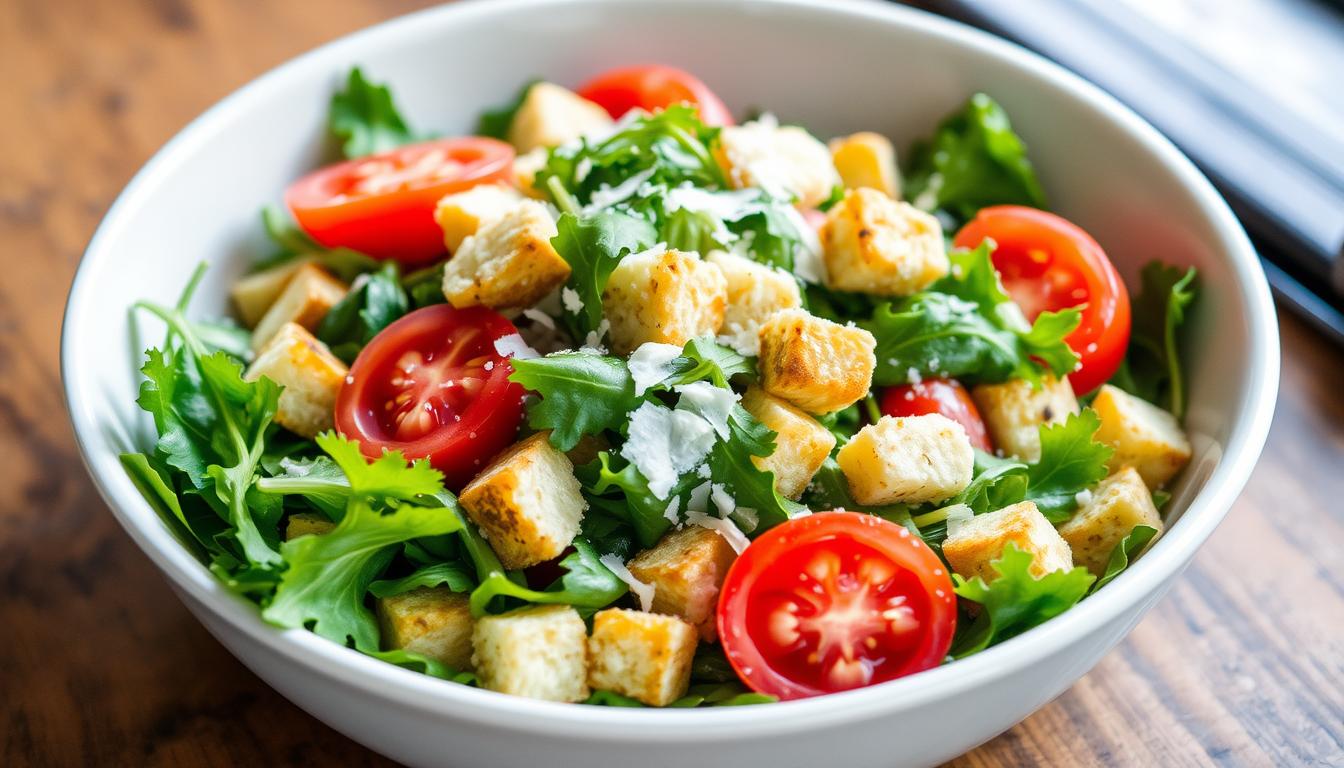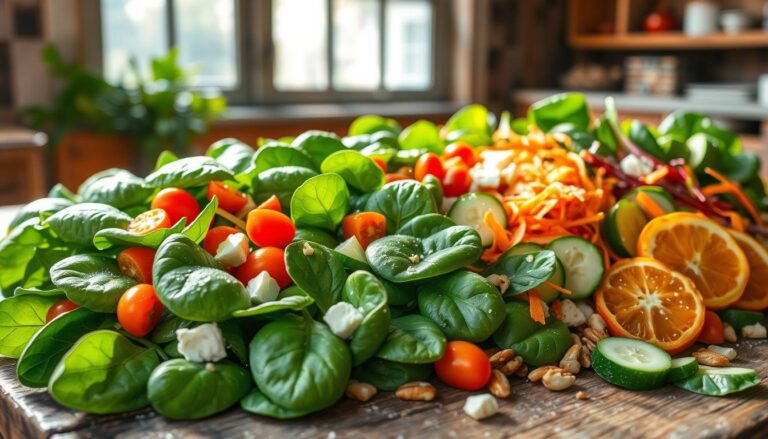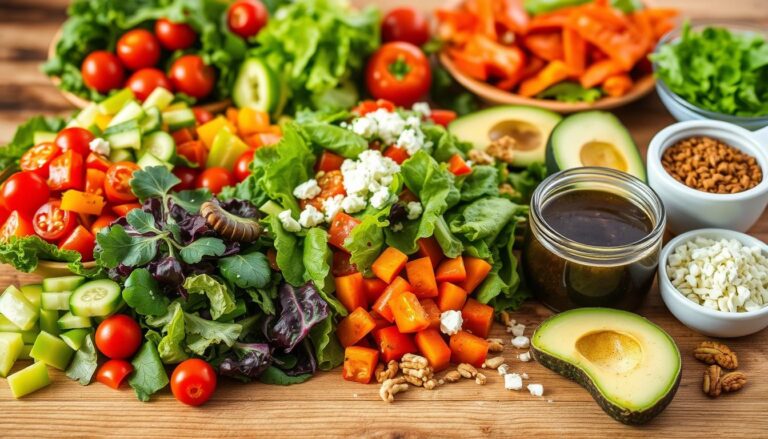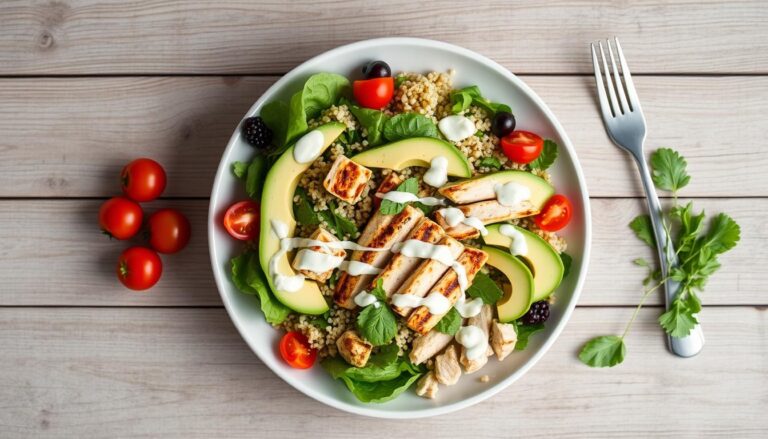How To Make The Famous Olive Garden Salad At Home – Step-by-Step Guide

Table of Contents
Every time I walked into Olive Garden, my heart would skip a beat. I knew the incredible house salad was coming. The crisp lettuce, tangy dressing, and croutons made a lasting memory.
What if you could make this legendary salad at home? Forget expensive restaurant bills and long waits. This guide will bring the Olive Garden experience to your table.
You’ll learn how to make a salad that rivals the restaurant’s. Our tutorial covers every step, from choosing the best ingredients to mastering the dressing. Whether you’re new to cooking or experienced, you’ll impress your loved ones with this salad.
Ready to unlock the secrets of America’s favourite salad? Your culinary adventure begins now!
The History Behind Olive Garden’s Famous House Salad
Explore the tasty history of Olive Garden’s famous salad. It’s a favourite since the 1980s. What started as a simple side dish became a big hit, making Olive Garden’s dining experience unforgettable.
A Culinary Journey of Flavour
Olive Garden worked hard to make its salad special. It went from a basic side to a key part of their salad bar. Its unique mix of ingredients makes it stand out among other salads.
- Introduced in the early 1980s
- Refined multiple times to perfect the recipe
- Became a signature dish within years
Why Customers Can’t Resist
People love this salad for good reasons:
| Attribute | Customer Appeal |
|---|---|
| Fresh Ingredients | Crisp, high-quality produce |
| Unique Dressing | Signature Italian vinaigrette |
| Complimentary Serving | Unlimited refills |
“Our salad is more than just a side dish – it’s an experience!” – Olive Garden Chef
The salad’s mix of flavours and textures is perfect. It’s a key part of Olive Garden’s tradition. Each ingredient is chosen to make a memorable experience, drawing customers back again and again.
7 Essential Tools for Restaurant-Quality Olive Garden Salad at Home
| ppliance/Tool | Brand | Description | Example Amazon Affiliate Product (US) |
|---|---|---|---|
| Mandoline Slicer | OXO | For ultra-thin, uniform cucumber slices (key for texture in Asian salads). | OXO Mandoline Slicer |
| Food Processor | Cuisinart | Quickly chops cucumbers, onions, or blends dressings. | Cuisinart Food Processor |
| Immersion Blender | KitchenAid | Blends dressings directly in bowls (e.g., sesame-garlic vinaigrette). | KitchenAid Immersion Blender |
| Digital Kitchen Scale | Escali | Precise measurements for dressing ingredients (sugar, vinegar, etc.). | Escali Digital Scale |
| Electric Spiralizer | Paderno | Creates fun cucumber ribbons/noodles for presentation. | Paderno Spiralizer |
| Vacuum Sealer | NutriChef | Extends salad freshness for meal prep (if storing dressed cucumbers). | NutriChef Vacuum Sealer |
| Handheld Torch | Sondiko | Lightly char toppings (e.g., sesame seeds or chili flakes) for enhanced aroma. | Sondiko Kitchen Torch |
Essential Ingredients for the Perfect Olive Garden Salad
Making an authentic Olive Garden salad begins with picking the right ingredients. Your homemade version will stand out when you choose each part carefully. This makes it a favourite in restaurants.
The base of this classic salad is a crisp romaine lettuce blend. It gives a fresh and vibrant start. Choose high-quality, crisp greens for the best texture and flavour.
- Romaine lettuce blends for crisp foundation
- Fresh, ripe tomatoes for bursts of colour
- Zesty pepperoncini for a tangy kick
- Crunchy croutons for added texture
Let’s look at the key ingredients that make this salad special:
| Ingredient | Purpose | Flavor Profile |
|---|---|---|
| Romaine Lettuce | Base of the salad | Crisp and fresh |
| Tomatoes | Add moisture and color | Sweet and juicy |
| Pepperoncini | Provide a spicy accent | Tangy and mild heat |
| Croutons | Add crunch | Garlic-seasoned texture |
Choosing top-notch ingredients is key. Your pepperoncini should be bright and pickled. Tomatoes should be ripe and juicy. Croutons should be perfectly seasoned. Together, they make a salad that’s as good as any restaurant’s.
Pro tip: Always choose fresh, high-quality ingredients to elevate your homemade Olive Garden-style salad.
Understanding the Signature Italian Dressing Components
Making the perfect Tuscan dressings needs precision and knowing each ingredient’s role. The Olive Garden’s iconic Italian vinaigrette turns a simple salad into a memorable meal.
To make a dressing like a restaurant, pick the right ingredients. Your homemade version will capture the charm of Olive Garden’s Tuscan dressings. These dressings make their salads so loved.
Key Ingredients for the Dressing
- Mayonnaise (provides creamy texture)
- White vinegar (adds tangy brightness)
- Olive oil (creates smooth consistency)
- Italian seasoning blend
- Garlic powder
- Dried herbs (oregano, basil)
- Salt and pepper
Mixing Techniques for Perfect Consistency
To get the right balance in your Italian vinaigrette, mix carefully. Whisk ingredients well to avoid separation. Start with dry spices, then add wet ingredients slowly.
“The secret is in the whisking – smooth and steady wins the flavor race!”
Storage and Shelf Life Tips
Your homemade Tuscan dressings will last up to one week in an airtight container in the fridge. Always shake well before using to mix ingredients again.
- Use glass containers for best preservation
- Keep refrigerated at 40°F or below
- Discard after 7 days
Pro tip: Let the dressing sit for 30 minutes before serving to allow flavours to meld together perfectly.
Selecting and Preparing Fresh Produce
Making an authentic Olive Garden salad begins with picking the freshest ingredients. Your salad bar’s quality depends on choosing the best produce. This ensures every bite is full of vibrant flavour and crisp texture.
When selecting tomatoes, look for ones that are ripe and firm with a deep red color. Stay away from tomatoes with blemishes or soft spots. Opt for vine-ripened or Roma tomatoes for the best taste.
- Select tomatoes that are heavy for their size
- Check for smooth, unblemished skin
- Smell the tomato – it should have a sweet, earthy aroma
The key to a top-notch salad is in how you prepare the vegetables. Wash all produce well under cool water. Use a vegetable brush for items like radishes or cucumbers.
| Produce Item | Selection Tip | Preparation Method |
|---|---|---|
| Lettuce | Crisp, bright green leaves | Chop into bite-sized pieces |
| Tomatoes | Firm, deep red color | Slice into uniform wedges |
| Red Onions | Smooth, heavy bulbs | Thinly slice rings |
Pro tip: Chill your prepared vegetables before making the salad. This keeps everything crisp and refreshing, just like Olive Garden’s salad bar.
Fresh ingredients are the foundation of an incredible salad experience!
Making Restaurant-Style Croutons at Home
Turning regular bread into tasty croutons can make your salads stand out. Making your crunchy croutons is simple and brings a restaurant feel to your kitchen.
Selecting the Perfect Bread
Choosing the right bread is key to great croutons. Use day-old Italian or French bread for the best texture and flavor. Soft or fresh bread won’t crisp up well.
- Day-old Italian bread
- French baguette
- Sourdough
- Ciabatta
Seasoning Techniques for Irresistible Croutons
Seasoning turns bread cubes into irresistible croutons. Mix olive oil with herbs like oregano, basil, and garlic powder. This mix matches the flavors of classic salads.
| Ingredient | Quantity | Purpose |
|---|---|---|
| Olive Oil | 3 tablespoons | Helps herbs stick to bread |
| Dried Oregano | 1 teaspoon | Adds Italian flavor |
| Garlic Powder | 1/2 teaspoon | Provides depth of flavor |
| Salt | 1/4 teaspoon | Enhances overall taste |
Baking for Perfect Crunch
Bake your seasoned croutons at 375°F for 10-12 minutes, turning once. Keep an eye on them to avoid burning. Aim for golden-brown edges and a crunchy texture that enhances your salads.
“Homemade croutons are the secret weapon of every great home chef!” – Culinary Expert
Follow these easy steps to make restaurant-quality croutons. They’ll elevate your house salad recipes to new heights.
The Art of Layering Your Salad Components
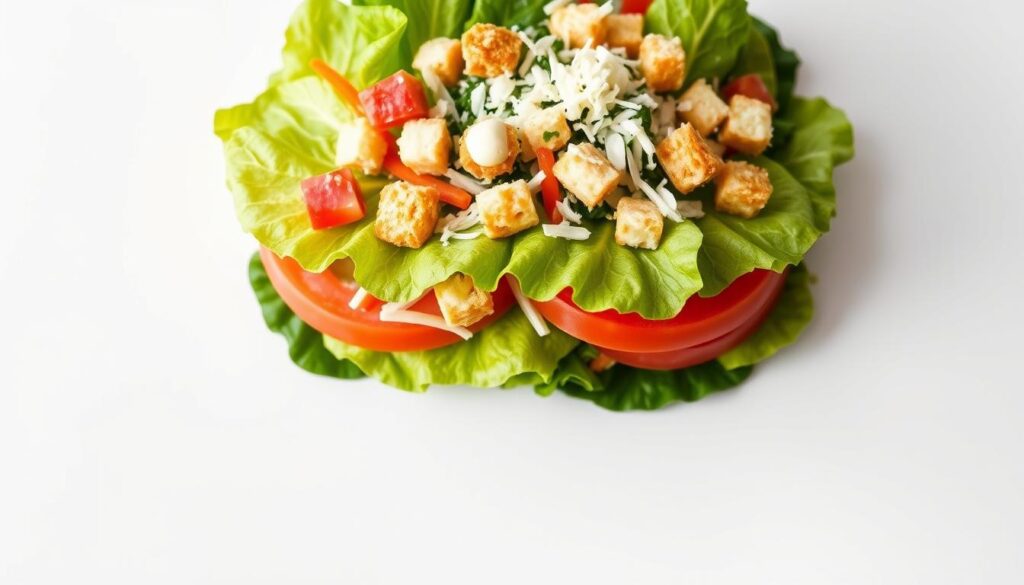
Making a perfect Olive Garden salad is more than just using great ingredients. It’s about how you layer them for a great taste. Learning to assemble your salad turns it into a feast for the eyes and taste buds.
Start with a fresh base of mixed greens. This is the foundation of your salad. Make sure to spread out the ingredients so every bite is full of flavour.
- Begin with a base of crisp romaine lettuce
- Add red onions for a sharp flavour contrast
- Sprinkle pepperoncini for a tangy kick
- Distribute olives evenly throughout
- Top with freshly grated Parmesan cheese
Professional chefs know that looks matter as much as taste. Strategically placed ingredients create a feast for the eyes. Think about color, height, and how you spread out your salad.
“A perfectly layered salad is like a culinary symphony – every ingredient plays a crucial role in the final performance.” – Culinary Expert
Pro tip: Use a large, wide bowl. This helps spread out the ingredients. It makes sure every bite has a mix of flavours, just like in top Italian restaurant salads.
| Layering Order | Purpose |
|---|---|
| Lettuce Base | Creates sturdy foundation |
| Vegetables | Adds color and nutrition |
| Proteins/Toppings | Provides texture and flavor |
| Cheese | Enhances overall taste |
| Dressing | Ties all components together |
Your goal is to mix everything for a restaurant-quality salad. With practice, you’ll get better at layering for the best taste.
Crafting the Perfect Homemade Italian Vinaigrette
Your Olive Garden salad needs a real Italian vinaigrette. It should taste like it’s from a restaurant. Making the perfect Tuscan dressing is easy with a few simple steps and the right ingredients.
The key to a great Italian vinaigrette is using fresh, quality ingredients. Also, knowing how to mix them right is crucial. Make sure you have everything ready before you start. This will make the process smooth.
Essential Mixing Instructions
- Select a clean glass jar with a tight-fitting lid
- Measure ingredients precisely for balanced flavour
- Shake vigorously for 30-45 seconds to emulsify
- Let the dressing rest for 10 minutes before serving
Expert Flavour Adjustment Tips
Make your Tuscan dressing your own by changing the ingredients. Want it tangier? Add more vinegar. For a smoother taste, add more olive oil. Homemade Italian vinaigrette is all about being flexible.
- Use fresh herbs for maximum flavour impact
- Adjust salt and pepper to taste
- Consider adding a touch of honey for subtle sweetness
With these tips, you’ll make an Italian vinaigrette that’s as good as any restaurant’s. Enjoy the rich, authentic taste of your homemade creation!
Time-Saving Prep Techniques for Bulk Preparation
Learning to make house salad recipes quickly is key. It saves time and keeps your food fresh. Setting up a salad bar in your kitchen can change how you prepare meals.
Professional chefs use smart prep to make meals fast. Spending a bit of time upfront makes salad-making much easier.
- Wash and chop vegetables in large batches
- Store prepped ingredients in airtight containers
- Organize ingredients like a professional salad bar
- Use clear containers for easy ingredient identification
“Preparation is the key to effortless, delicious salads.” – Culinary Expert
Turn your fridge into a personal salad bar with these tips. Keep wet and dry ingredients separate to keep things crisp. Use containers with different sections to keep things fresh and organised.
For the best freshness, follow these tips:
- Chop lettuce just before using
- Store dressing separately
- Keep croutons in a sealed container
- Refrigerate cut vegetables within two hours of preparation
Pro tip: Label your containers with preparation dates to track freshness and reduce food waste.
Storage Solutions for Salad Components

Keeping your salad ingredients fresh is key for that restaurant taste. Your romaine lettuce and other parts need careful storage. This keeps them crisp and flavorful.
Here are some storage tips to keep your salad fresh:
- Romaine lettuce blends should be stored in a sealed container with a paper towel to absorb excess moisture
- Keep pepperoncini in their original jar, refrigerated with the lid tightly closed
- Wrap fresh vegetables in slightly damp paper towels to maintain humidity
- Store dressing in an airtight container in the refrigerator for up to one week
For the best freshness, keep wet and dry ingredients apart. Tomatoes, cucumbers, and other moisture-rich vegetables should be stored away from romaine lettuce. This prevents them from getting soggy.
Pro tip: Always wash and thoroughly dry your produce before storage to prevent premature spoilage.
Proper storage keeps your ingredients fresh longer. It also makes sure every salad is crunchy and fresh. Pepperoncini and other delicate ingredients stay tangy when stored right.
Common Mistakes to Avoid When Making Italian Restaurant Salads
Making the perfect Olive Garden salad at home can be tricky. Many home cooks make critical errors. These mistakes can turn a delicious salad into a disappointing meal.
- Overdressing the Salad: Too much dressing kills the crisp texture of fresh ingredients
- Using Wilted Produce: Always choose the freshest vegetables possible
- Ignoring Temperature: Serve your salad chilled for maximum flavour
Your salad’s success depends on precision and attention to detail. Avoid drowning your greens in dressing. This can make them soggy and unappetizing. A light touch is key when applying your homemade vinaigrette.
| Common Mistake | Recommended Solution |
|---|---|
| Warm Ingredients | Chill vegetables before assembling |
| Uneven Dressing | Toss gently to distribute evenly |
| Stale Croutons | Make fresh croutons before serving |
Temperature plays a crucial role in your Olive Garden salad’s appeal. Refrigerate ingredients beforehand. Serve immediately after mixing to maintain that fresh, crisp restaurant-quality experience.
Pro tip: Less is more when it comes to salad dressing!
By avoiding these common pitfalls, you’ll transform your homemade Italian restaurant salads from mediocre to magnificent.
Health Benefits and Nutritional Information
Making house salad recipes at home lets you control what goes into your food. Your homemade Olive Garden-style salad can be very healthy if you choose the right ingredients.
Knowing what’s in your salad helps you make better food choices. House salads are full of nutrients that are good for your health.
Caloric Content Overview
A typical serving of Olive Garden-style salad has about 150-180 calories. Here’s what it usually includes:
- Lettuce: Low-calorie base (10-15 calories)
- Vegetables: Minimal caloric impact
- Croutons: Around 50-60 calories
- Dressing: Approximately 100 calories
Dietary Modifications
Salad bars let you tailor your meal to fit your diet. Here are some tips:
- Low-Carb Option: Skip the croutons and use less dressing
- Vegan Adaptation: Use nuts or seeds instead of cheese
- Gluten-Free Version: Choose gluten-free croutons or don’t use them
By changing a few ingredients, you can make your salad healthier and meet your dietary needs.
Conclusion
Making the perfect Olive Garden salad at home is more than a recipe. It’s a chance to bring restaurant-quality meals to your kitchen. By using the techniques and tips we’ve shared, you can make a salad that’s just as good as the one at the restaurant.
Your homemade Olive Garden salad is very flexible. You can change ingredients to fit your diet, control how much you make, and save money. The skills you’ve learned are not just for salads. They’re about understanding flavours, how to prepare, and how to present food.
Cooking is always something new to learn. Every time you make this salad, you’ll get better and appreciate the flavours of Italian food more. Your kitchen is now ready to make amazing dishes that will wow everyone.
Whether you’re planning meals for the week or making a special dinner, your salad skills will help. Enjoy cooking, try new things, and savour every bite of your delicious salad.
FAQ
How long can I store the homemade Olive Garden salad dressing?
Can I make the Olive Garden salad ahead of time?
Are there any gluten-free modifications for this salad?
How can I make the salad more protein-rich?
What can I substitute if I don’t like pepperoncini?
How do I keep my lettuce crisp when prepping in advance?
Can I make a vegan version of this salad?
What’s the best way to slice tomatoes for the salad?
How did you find this recipe?
There are no reviews yet. Be the first one to write one.

